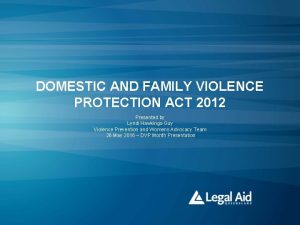Associations Among Domestic Violence Exposure Depressive Symptoms and

- Slides: 1

Associations Among Domestic Violence Exposure, Depressive Symptoms, and Substance Use Among Adolescent Residents of Urban Detroit Will Sturdavant (1), Dayna Leplatte MD (2), Brent Williams MD, MPH (3), Andrea Matthew (1) 1. University of Michigan Medical School; 2. University of Michigan Department of Psychiatry; 3. University of Michigan Department of Internal Medicine Introduction Current literature has shown associations between domestic violence exposure (DVE) and depression, substance use, as well as many other developmental factors 2, 4, 5. There is substantially less literature on the sequelae of DVE among urban adolescents. Current estimates of DVE among adolescents are often based on law enforcement records and are considered widely to underestimate the actual prevalence of DVE due to various factors (low reporting numbers, misclassification, etc. ). We worked with the Central Detroit Christian Community Development Corporation (CDC-CDC) to obtain a better understanding of the rates of DVE and its effects on the adolescent participants of its summer employment program. Objectives ● Determine the prevalence and severity of DVE, depression, and substance use in the adolescent community of Central Detroit Christian Community Development Corporation (CDC-CDC) summer employees ● Examine relationships between DV, depression, and substance use within this group. Results A Results (cont. ) Witness to Family Violence Sexual Abuse Family Violence Exposure Child Maltreatment B 13. At any time in your life, did you SEE a parent hit, beat, kick, or physically hurt your brothers or sisters, not including a spanking on the bottom? 11. At any time in your life, did a grown-up you know touch your private parts when they shouldn’t have or make you touch their private parts? Or did a grown-up you know force you to have sex? 8. At any time in your life, did one of your parents get hit or slapped by another parent? 1. Not including spanking on your bottom, at any time in your life, did a grown-up in your life hit, beat, kick, or physically hurt you in any way? Figure 1. Responses to the JVQ-A questionnaire. (A) Illustrates the positive response rate in each category of DVE. (B) Provides example questioning from each section. 76. 7% of participants reported some kind of DVE in their lifetime. 3 1 Methods ● Survey designed using: ○ Questions from the Juvenile Victimization Questionnaire, Revision 2 (JVQ-R 2)3 ○ The Patient Health Questionnaire for Adolescents (PHQ-A) ○ Questions adapted from the Car, Relax, Alone, Forget, Friends, Trouble (CRAFFT) screening tool ● 43 participants of the CDC-CDC employment program given survey anonymously ○ Participant demographics: 42 African American, 1 White, all age 14 -20 ● Responses divided into groups based on depressive symptomatology and recent substance use ● Two-sampled t-tests were used to determine any significant differences in DVE between the groups ● Participants who admitted to ever riding in a car driven by someone under the influence of substances scored on average 1. 9 points higher (p=0. 018) on DVE than their peers. ● Admitting to substance use within the past year was more weakly associated (p=0. 09) with a 1. 4 -point increase in DVE. Conclusions ● The high prevalence of DVE among urban youth presents great opportunities for intervention for health professionals ● Admission of having ridden in a car with someone under the influence may prompt further investigation into possible DVE ● Further investigation, with larger sample sizes, is needed to investigate the weaker association between DVE and recent substance use ● The lack of association of DVE and recent substance use and depression may indicate the resilience of this adolescent population ● While these findings are preliminary and require further study with larger sample sizes, this presents exciting implications for improvements in screening for DVE, depression, and substance use Acknowledgements We are incredibly grateful to the CDC-CDC and its director, Lisa Johanon, for allowing us to work with and alongside the participants of its summer employment program. We are also very grateful to Dr. Marcia Valenstein and the Qualitative and Mixed Methods Learning Lab for their contributions in the development of the methods used in this study. References Figure 2. Mean DVE scores of participants in various groupings. Responses were grouped based on whether they claimed to have ridden in a car with a driver who was intoxicated, had used illicit substances within the last 12 months, and on their depression symptomatology as determined by the PHQ-A. Two sample t-tests were used to determined statistical significance of the differences found between each of the means. This research was funded by the University of Michigan Summer Biomedical Research Program. We are grateful for their support in pursuing this research project. 1. [CDC]. Gardens & Orchard. Available at: http: //centraldetroitchristian. org/portfolio-item/gardens-orchard/. Accessed October 16, 2016. 2. Edleson JL. Children's witnessing of adult domestic violence. Journal of Interpersonal Violence 1999; 14(8): 839– 870. 3. Finkelhor D, Hamby S, Turner H, Omrod R. The Juvenile Victimization Questionnaire: 2 nd Revision (JVQ-R 2). Crimes Against Children Research Center 2011. 4. Hughes HM, Parkinson D, Vargo M. Witnessing spouse abuse and experiencing physical abuse: a "double whammy"? Journal of Family Violence 1989; 4(2): 197– 209. 5. Sternberg KJ, Lamb ME, Greenbaum C, Cicchetti D. Effects of domestic violence on children's behavior problems and depression. Developmental Psychology 1993; 29(1): 44– 52.

